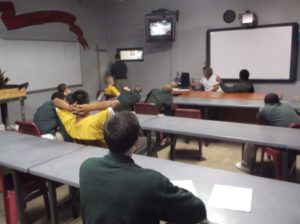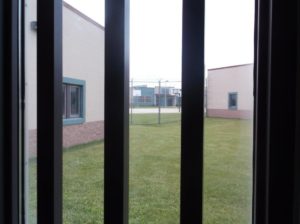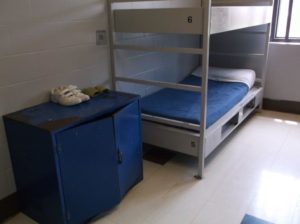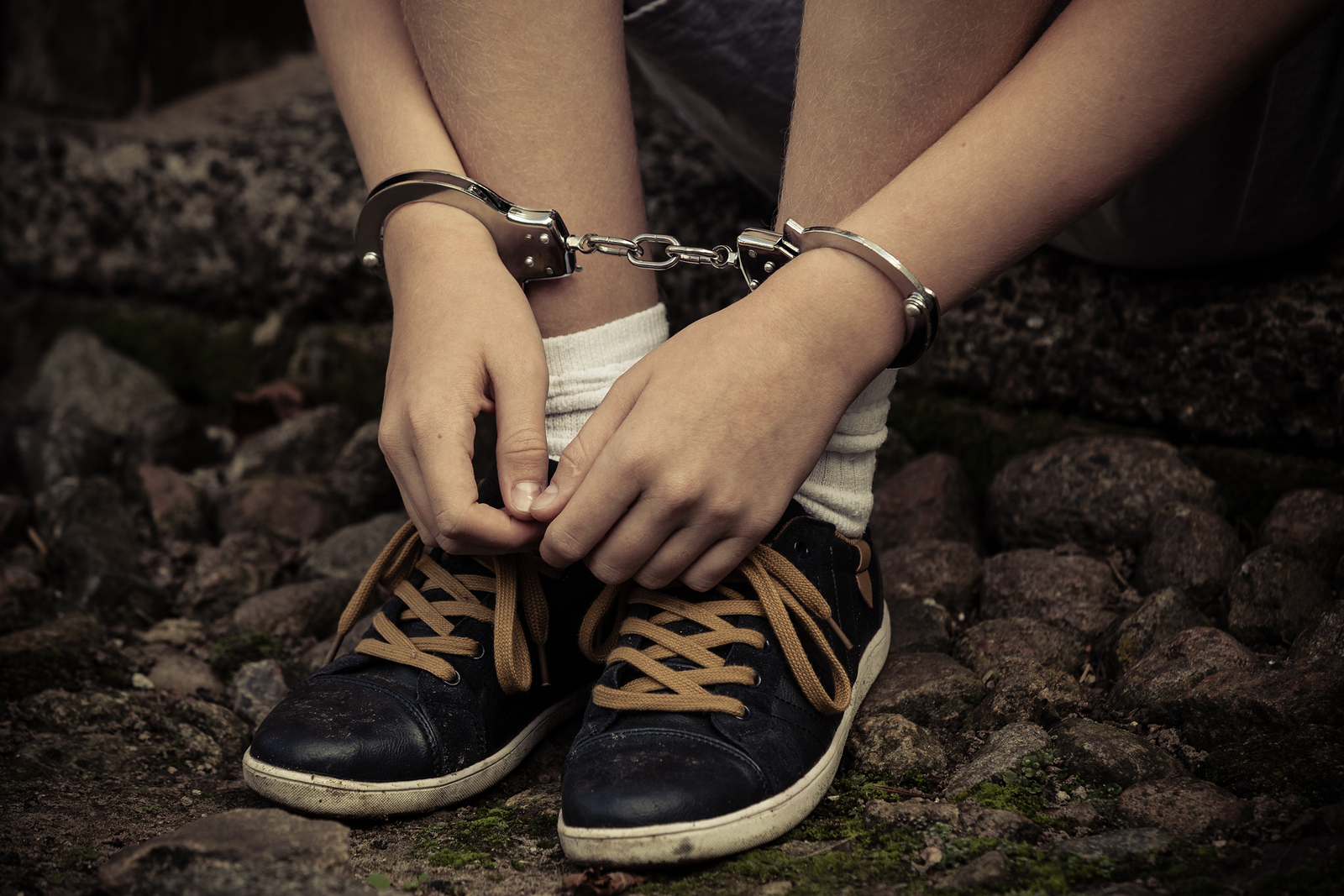Inside Indiana’s Juvenile Justice System

Nick’s story begins in a way that likely sounds unspectacular to many teens. A sophomore in high school from a small town in Indiana, he had a job delivering pizzas to balance with school. At one point, a friend who was prescribed ADHD medication gave Nick a few pills to try out. Nick took them, liked them, and started up a habit.
That kind of drug use alone could have gotten him into trouble. The turn his story took next is what got him housed alongside some of the most difficult cases in Indiana’s criminal juvenile justice system. Now, four years into his stay at the Pendleton Juvenile Correctional Facility on the outskirts of metropolitan Indianapolis, Nick sits in one of the internally housed school’s conference rooms and describes how he got locked up.
He says that it happened on a day he didn’t realize he wasn’t scheduled to work. He went into the pizza parlor and was instead sent home with his paycheck. High on the stimulants he was buying from his friend, Nick said he started to do the math and realized that between buying drugs and gas to fill up his car, he was going to have nothing left over. He looked out the window and saw a local bank by the side of the road. On a lark, he decided to rob it.
“The idea just popped in my head. So I drove home real quick. My mom had a gun in the house—so I grabbed that, and the mask.”
All told, Nick came away with $16,000 in cash (fortunately no one was injured). He says he didn’t get caught until he bragged about it to a friend a week later, who then promptly turned him in.
Nick’s story is illustrative, because it resonates with what the staff say repeatedly about the teenagers living on lockdown in Pendleton. Though some have psychological disorders—and many have special needs or learning disabilities—and all of them have committed serious offenses ranging from assaults to rapes and murders—at the end of the day, they are still “kids” in need of patience and positive emotional reinforcement. The big difference, according to the teachers, counselors, and guards that watch over them 24 hours a day, is an unusually acute lack of impulse control—and teenage boys aren’t exactly renowned for their self restraint to begin with.
“We see a lot of conduct disorders and oppositional defiance,” said Derek Grubbs, who spent years overseeing educational programs at Pendleton and is now the acting education director for the entire statewide program. Grubbs said that the job of educating the teens at Pendleton is particularly difficult because in many cases they have been failed by their home school districts.

A classroom in the High School at Pendleton Juvenile Detention Center outside of Indianapolis, Indiana. (InsideSources)
In recent months, Indiana’s work with juvenile offenders has gotten attention at the national level. As lawmakers in Washington D.C. were working to reauthorize the main federal juvenile justice law, a top official from the state was invited to testify before Congress. (Both the House and Senate have since passed the Juvenile Justice reauthorization by wide bipartisan margins, and the bill has moved into a conference committee).
A key element of Indiana’s success in the difficult field, according to state officials and those on sight at Pendleton, is a focus on rehabilitation and education for the teenagers in the system. In fact, the guards and administrators often refer to the boys living behind the barbed wire fences as “students.” The term is appropriate if only for the amount of time the boys spend in class. The offenders at Pendleton have no summer breaks—their school year runs from July 1st to June 30th. Furthermore, Grubbs explained that every teacher in the school is required to have a special education certification, in large part because more than half of the students at Pendleton are on Individualized Educational Programs.
The caretakers also say that they have cut down significantly on their use of solitary confinement, and have trained themselves in de-escalation techniques. When a student acts out in class, they get sent to a counselor’s office. Physical restraint is used as a last resort, and good behavior is tracked on a five-point scale that is then rewarded with comfort food and extra privileges.
Chris Blessinger, a former counselor at Pendleton that is now the executive director for the entire state’s Division of Youth Services, explained that to leave Pendleton, a student must maintain at least a 4.0 behavioral average. “We don’t like to think in terms of punishment here, more consequences. Ultimately, it’s about leading them to make the right decisions,” she said.
Another common refrain from Blessinger and her underlings is that the high school housed within the Pendleton facility was purposefully designed with the look and feel of a regular public school in mind. (The officials have given the school on the grounds a separate name, Providence High School, in a bid to make the students slightly more employable as they transition back to the outside world). In many respects, it is true that the education spaces have a familiar boys-school feel. The hallways feature displays of student work, including the final project from a recent unit on the Holocaust led by veteran English teacher Mandy DeHart. Inside the classrooms, neat rows of desks face forward toward digital smart-boards that carry lesson plans and PowerPoint presentations.
As a full-time teacher, DeHart is also assigned a caseload of students to work with and get to know. Similar to the duties of an especially hands-on homeroom teacher, DeHart meets with the boys assigned to her at least once a month, and has the responsibility of advocating on their behalf with other teachers like a parent would. Through this process, DeHart explains that she gets to know some of her students personally and that they seem to respond to the one-on-one attention from an adult role model.

A look onto the yard through the barred windows of a cell at Pendleton. Offenders typically spend between a few months to a year at the facility. (InsideSources)
While the staff at Pendleton has consciously tried to recreate the feel of a standard school, the reality of the setting is also apparent as the students trickle in from their lunch break across the yard—Providence High School is no ordinary public school. Guards bark at the students to stand quietly in single file lines, which the students are required to maintain as they move from class to class. Blue tape on the ground in the hallways delineates where the students are and are not allowed to walk, (so the staff can have clear lines of sight at all times). Most of the boys wear dark green, long sleeve shirts, and many have serious expressions. They shuffle along in their white velcro shoes (laces are not permitted to most for fear of suicide). Within minutes of the beginning of the first period after lunch, guards had to interrupt a class to question and search students in the hallway over allegations that one of the boys was being intimidated into giving up his belongings.
But overall, the program seems to be working for a number of the students. Nick, who is now 20 and only months away from release, recently earned a high school diploma behind bars. The faculty work with each student to get them thinking about a career for after they are released. Part of that career preparation is a robust horticulture program. A large greenhouse behind the school offers students an opportunity to learn about plant life, and get their hands dirty.
The school administrators prefer to get their students to transfer the credits they earn at Pendleton towards degrees from their home school districts, but when that’s not possible, many end up sitting for high school equivalency exams. For students, like Nick, hoping to attend community college upon release, the staff helps them put together resumes, cover letters, and college or job applications.
In this way, the roughly 160 boys at Pendleton receive personalized attention, which is a first for many of them. Because the facility actually employs more staff than inmates, and because of all the nursing and counseling resources available to them, the costs of running the facility are high on a per student basis. Statistics provided by Blessinger show that the facility spends about $250 per day on each student, which translates to tens of thousands per year.
This level of spending is possible because of how small the population of detained juveniles in the state is. Of the roughly 1.1 million K-12 aged children in Indiana, only about 420 are behind bars in the state-run facilities (and of those only about 30 are female, who are housed in an entirely separate facility).

Inside a cell at Pendelton Juvenile Detention Center. While the classrooms in the facility are modeled on the look and feel of a traditional public school, living quarters resemble an adult prison. (InsideSources)
And according to the statistics provided by Blessinger, the efforts are paying off. Only a third of the teens released from the Indiana system end up back at a juvenile detention facility, and more than 80 percent are able to stay out of the adult correctional system. Those low recidivism rates far outstrip the rates of repeat offenses among adults.
The manageable numbers also allow the staff to be flexible in how they house their students. Outside of the dark green shirts worn by the students in general population, some of the more violent and dangerous students wear light green shirts, the sexual offenders wear yellow shirts, while Nick is among the select group of students permitted to wear camouflage fatigues with a black shirt and tall black boots. Nick is part of the pre-military unit. His housing block is adorned with murals of muscle-bound soldiers and flags representing different branches of the armed service. Entering into this program, which also includes sessions of vigorous physical training, is a privilege, and one that Nick says keeps him focused and centered. He has taken well to the program that the staff appointed him to be a leader on the unit. He takes clear pride in his responsibilities, which include making sure the living quarters stay impeccably clean.
“They’re more understanding; they know where we come from,” Nick said of the staff before trailing off. Between the lack of distractions, and being surrounded by adults that are invested in his success, Nick explains that he has been able to focus on his schoolwork and has blossomed into becoming an avid reader. While the signs look good for him, whether he is able to make the successful leap back into everyday society, however, is still an open question.
While he appreciates how the structure and rigor at Pendleton has reshaped his life and kept him out of trouble, he also chafes at the restrictions. When, sitting alongside a fellow inmate, named Max, asked about the discipline expected of them, the pair answered simultaneously:
“It sucks,” “It’s lame.”
Anywhere from a few months to a few years from now, both will be back on the streets in Indiana. Whether they, and their peers, end up making a positive or a negative impact on their communities is dispositive of the question on whether the education-focused programming at Pendleton has been successful. But based on the national attention Indiana’s system has received and the states sending delegations to replicate their work, it appears that the early returns are good.




